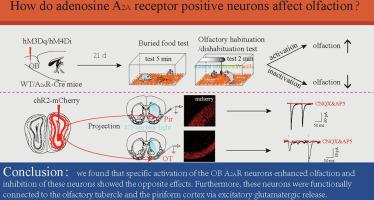Brain Research ( IF 2.9 ) Pub Date : 2021-07-24 , DOI: 10.1016/j.brainres.2021.147590 Xiao Sun 1 , Lei Li 1 , Hu-Yun-Long Zhang 1 , Wei He 1 , Dian-Ru Wang 1 , Zhi-Li Huang 1 , Yi-Qun Wang 1

|
Depression, rapid eye movement (REM) sleep behavior disorder, and altered olfaction are often present in Parkinson's disease. Our previous studies demonstrated the role of the olfactory bulb (OB) in causing REM sleep disturbances in depression. Furthermore, adenosine A2A receptors (A2AR) which are richly expressed in the OB, play an important role in the regulation of REM sleep. Caffeine, an adenosine A1 receptors and A2AR antagonist, and other A2AR antagonists were reported to improve olfactory function and restore age-related olfactory deficits. Therefore, we hypothesized that the A2AR neurons in the OB may regulate olfaction or odor-guided behaviors in mice. In the present study, we employed chemogenetics to specifically activate or inhibit neuronal activity. Then, buried food test and olfactory habituation/dishabituation test were performed to measure the changes in the mice's olfactory ability. We demonstrated that activation of OB neurons or OB A2AR neurons shortened the latency of buried food test and enhanced olfactory habituation to the same odors and dishabituation to different odors; inhibition of these neurons showed the opposite effects. Photostimulation of ChR2-expressing OB A2AR neuron terminals evoked inward current in the olfactory tubercle (OT) and the piriform cortex (Pir), which was blocked by glutamate receptor antagonists 2-amino-5-phosphonopentanoic acid and 6-cyano-7nitroquinoxaline-2,3-dione. Collectively, these results suggest that the OB mediates olfaction via A2AR neurons in mice. Moreover, the excitatory glutamatergic release from OB neurons to the OT and the Pir were found responsible for the olfaction-mediated effects of OB A2AR neurons.
中文翻译:

嗅球中的腺苷 A2A 受体神经元介导小鼠的气味引导行为
抑郁症、快速眼动 (REM) 睡眠行为障碍和嗅觉改变通常存在于帕金森病中。我们之前的研究证明了嗅球 (OB) 在引起抑郁症患者快速眼动睡眠障碍中的作用。此外,在OB中丰富表达的腺苷A 2A受体(A 2A R)在调节REM睡眠中起重要作用。据报道,咖啡因、腺苷 A 1受体和 A 2AR拮抗剂以及其他 A 2AR拮抗剂可改善嗅觉功能并恢复与年龄相关的嗅觉缺陷。因此,我们假设 A 2AOB 中的 R 神经元可以调节小鼠的嗅觉或气味引导行为。在本研究中,我们采用化学遗传学来特异性激活或抑制神经元活动。然后,进行掩埋食物试验和嗅觉习惯/去习惯测试,以测量小鼠嗅觉能力的变化。我们证明了OB神经元或OB A 2A R神经元的激活缩短了掩埋食物测试的潜伏期,增强了对相同气味的嗅觉习惯和对不同气味的不习惯;对这些神经元的抑制显示出相反的效果。表达 ChR2 的 OB A 2A的光刺激R 神经元末端在嗅结节 (OT) 和梨状皮层 (Pir) 中诱发内向电流,该电流被谷氨酸受体拮抗剂 2-amino-5-phosphonopentanoic acid 和 6-cyano-7nitroquinoxaline-2,3-dione 阻断。总的来说,这些结果表明 OB 通过小鼠的 A 2A R 神经元介导嗅觉。此外,发现从 OB 神经元向 OT 和 Pir 的兴奋性谷氨酸能释放是 OB A 2A R 神经元的嗅觉介导作用的原因。


























 京公网安备 11010802027423号
京公网安备 11010802027423号